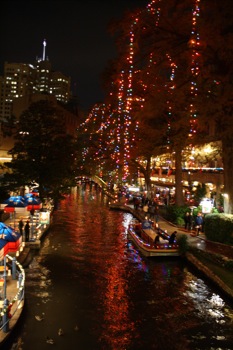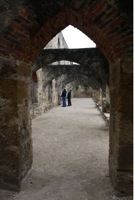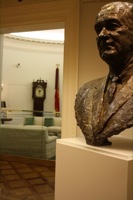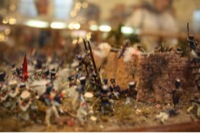
I felt like I was walking through some kind of fairyland on the winding sidewalk beside towering trees, stone bridges, waterfowl and occasional waterfalls. Fortunately, I strolled the path often on my San Antonio Christmas on the River Walk tour with Mayflower Tours in December. The Drury Plaza Hotel, where I stayed, not only had a history as the luxurious Alamo Bank but also claimed an ideal location along the River Walk in the heart of downtown.
From this route, I could easily reach Texas barbecue, steak, souvenirs and other specialty shops along the three-mile Christmas wonderland to get a taste of the Lone Star State.
Spainards with a mission
Hints of San Antonio’s Spanish Colonial connection still appear prominently in the city’s architecture and historic attractions, such as the San Fernando Cathedral and Mission San Jose. With a gold altar immediately drawing the eye to the back of the church, the San Fernando Cathedral not only remains at a prominent location in downtown but also serves as one of the city’s most important structures, since it is the oldest continuously functioning religious community in the state of Texas.
 “This is a significant building not only for religious reasons, but also for historic ones,” said Mary Jurewicz, city tour guide for San Antonio. “People’s lives revolved around the church when this mission was built. It was the center of so many important things that happened in San Antonio.”
“This is a significant building not only for religious reasons, but also for historic ones,” said Mary Jurewicz, city tour guide for San Antonio. “People’s lives revolved around the church when this mission was built. It was the center of so many important things that happened in San Antonio.”
The 1749 cathedral’s gray Gothic interior features 1920 stained-glass windows, an 18th-century hand-carved baptismal font and statues of Mary and St. Ferdinand. I toured the stunning church between Sunday services with a guide, who explained the symbolism and cultural significance of San Fernando.
Not far off, the stone walls encircling Mission San Jose demonstrate the use of missions as communities and not just religious centers. Inside the visitors center, a video, exhibits and a map of the site introduced me to the mission lifestyle.
“The births could never keep up with the deaths,” said Jurewicz. “That’s why the missions didn’t work. Measles, smallpox and cholera were common.”
Part of the San Antonio Missions National Historic Park, Mission San Jose is known as the Queen of the Missions, because it is the largest of the missions and was almost fully restored in the 1930s by the Works Projects Administration. The mission church boasts the 1775 Rose Window, one of the more detailed examples of baroque architecture in North America.
 “This church is more elaborate than some in Europe, because the limestone can be worked like woodwork,” said Jurewicz. “It is covered in Spanish colonial ornamental sculpture. It is the third most visited spot in San Antonio.”
“This church is more elaborate than some in Europe, because the limestone can be worked like woodwork,” said Jurewicz. “It is covered in Spanish colonial ornamental sculpture. It is the third most visited spot in San Antonio.”
After touring the still active church, I switched from San Antonio’s Spanish influence to Mexican influence at the Mexican Market.
“This is the largest Mexican market outside Mexico,” said Jurewicz. “It has restaurants, silver, pottery and almost anything you would find in a typical Mexican market.”
Tin Christmas ornaments, Day of the Dead figurines and wood-carved alebrijes showcased various types of Mexican crafts, while other booths offered non-Mexican items as well, such as food and souvenirs. Traditional live Mexican dancing in the center of the market set the mood so well that I could easily imagine myself south of the border.
LBJ today
I found myself face to face with a figure who helped pass civil rights legislation while encouraging Americans to take the first steps on the moon at the Lyndon Baines Johnson Presidential Library Museum in Austin. The exhibits of the museum cover all aspects of Johnson’s life and presidency, including “the Humor of LBJ,” where a life-sized animatronic figure of the president told some of the stories Johnson loved to tell.
 My trip to the museum started with a 20-minute introductory video about how one man rose from humble beginnings in Texas to the head of a nation.
My trip to the museum started with a 20-minute introductory video about how one man rose from humble beginnings in Texas to the head of a nation.
“It is interesting to see what his life was like as a president and to learn about the long hours he would work,” said Jurewicz. “Lyndon B. Johnson insisted that no one should be charged to come into the museum. You can visit exhibits on three floors for free.”
The museum’s exhibits cover not only the president’s life, but also the state of the country during Johnson’s time and the life of his wife, Lady Bird Johnson.
After leaving the museum for the Sauer-Beckmann Farmstead in nearby Johnson City, the smells of curds and whey that Little Miss Muffet was once supposed to have eaten in the traditional nursery rhyme became real to me. The living-history farm, located within the Lyndon B. Johnson State Park and Historic Site, portrays the working lifestyle of a 1918 Texas farm similar to the one on which Johnson grew up.
Costumed interpreters perform daily chores typical of early-20th-century farmers, such as cooking curds and whey on an oven stove. To make the experience even more believable, the farm showcases period farm equipment and live farm animals, such as the rather intimidating Texas longhorn cattle.
 At the nearby Lyndon B. Johnson National Historic Park, I saw how much the lifestyle of the president changed after running for office and buying the Texas White House, the mansion in which Johnson resided from 1951 until his death in 1973. A walk through the house, now renovated to look as it did in the 1960s, left me feeling as though I knew the Johnsons personally from various stories from my house guide.
At the nearby Lyndon B. Johnson National Historic Park, I saw how much the lifestyle of the president changed after running for office and buying the Texas White House, the mansion in which Johnson resided from 1951 until his death in 1973. A walk through the house, now renovated to look as it did in the 1960s, left me feeling as though I knew the Johnsons personally from various stories from my house guide.
“They had 72 phones because they didn’t have cell phones, so Johnson had them installed everywhere,” said guide Cynthia Dormeny. “He loved the phone; he was always on it. Lady Bird, however, was not a fan of his phone on the dining room table. Johnson would’ve really enjoyed cell phones.”
The park preserves the 8,500-square-foot home, as well as Johnson’s boyhood home and grave.
Remembering the Alamo
Although I knew the epic importance of the Alamo from the John Wayne movie, I was interested in finding out where Hollywood ended and where the truth began at the Alamo National Historic Landmark. To prepare, I watched The Alamo: The Price of Freedom at the Rivercenter Imax Theater. The Imax production brings the danger of 200 Texans fighting 3,000 Mexican forces up close with cannon blasts and larger-than-life special effects.
 Although the only remaining building from the original Alamo mission seems small compared with the sprawling size of the battle, I found the church steeped in history with impressive exhibits and artifacts, such as a lock of Davy Crockett’s hair, William Travis’ ring and James Bowie’s knife.
Although the only remaining building from the original Alamo mission seems small compared with the sprawling size of the battle, I found the church steeped in history with impressive exhibits and artifacts, such as a lock of Davy Crockett’s hair, William Travis’ ring and James Bowie’s knife.
“In 1718, when the first hoe hit the ground here, the Alamo was a mission,” said Jurewicz. “A mission isn’t just a church; it’s a city. Now, all that’s left is the church.”
The chapel served as a sanctuary for women and children during the 1836 battle, yet periodic programs inside relate the story of the entire battle and its impact on the eventual freedom of Texas.
“It was a desperate struggle for their lives, but in the end they were simply outnumbered,” said David Smith, Alamo National Historic Landmark guide. “The outrage caused by the heroic efforts of Travis and his men incited 1,000 volunteers to fight for Sam Houston and eventually win Texas’ independence.”
 Cannonballs, muskets, dioramas and other artifacts from the battle fill the church and surrounding buildings to help guests imagine the iconic battle.
Cannonballs, muskets, dioramas and other artifacts from the battle fill the church and surrounding buildings to help guests imagine the iconic battle.
After a day contemplating the violence highlighted in American history books, the pace of our trip slowed with a dinner cruise by Rio San Antonio Cruises down the still shimmering River Walk. For 10 miles, I glided underneath the 122,000 Christmas lights and past restaurants and stores while leisurely taking in the fantastic beauty.
Even the relaxing ride turned into an interesting history lesson when our cruise driver began relating stories of how engineers dreamed up the River Walk.
“When they made this man-made point of the river, they needed to figure out a way to keep it from being stagnant,” said Alex Alonso. “So the engineers got together, did a lot of thinking, drank a lot of coffee and came up with the waterfalls, which you can see along the walk to keep the water moving.”
I also appreciated the scenic advantages of the lighted waterfalls along our route as I tried to memorize the serene beauty of San Antonio’s Christmas River Walk.









